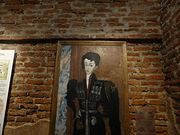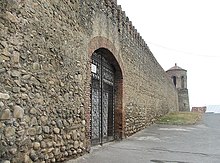Heraclius II of Georgia
| Heraclius II | |
|---|---|
King of Kakheti | |
| Reign | 1744–1762 |
| Predecessor | Teimuraz II |
| Born | 7 November 1720 Telavi |
| Died | 11 January 1798 (aged 77) |
| Burial | |
| Consort | Ketevan Orbeliani or Ketevan Pkheidze Anna Abashidze Darejan Dadiani |
| Issue among others... | George XII |
| Dynasty | Bagrationi |
| Father | Teimuraz II |
| Mother | Tamar of Kartli |
| Religion | Georgian Orthodox Church |
| Khelrtva |  |
Heraclius II, also known as Erekle II (
From being granted the kingship of Kakheti by his overlord
Early years


Service under Nader Shah
Born in
Nader's death and reign in Kakheti
Yet, both Georgian kingdoms remained under heavy Persian tribute until Nader was assassinated in 1747. Teimuraz and Heraclius took advantage of the ensuing political instability in Persia to assert their independence and expelled Persian garrisons from all key positions in Georgia, including
King of Kartli and Kakheti


Around the same time, it had become apparent that
Alliance with Russia
In foreign policy, Heraclius was primarily focused on seeking a reliable protector that would guarantee Georgia's survival. He chose Russia not only because it was
In 1783, the Russian expansion southward into the Crimea brought the Caucasus into Catherine II's area of interest. In the Treaty of Georgievsk of 1783, Heraclius finally obtained the guarantees he had sought from Russia, transforming Georgia into a Russian protectorate, as Heraclius formally repudiated all legal ties to Persia and placed his foreign policy under the Russian supervision. However, during the Russo-Turkish War (1787–1792), a Tbilisi-based small Russian force evacuated Georgia, leaving Heraclius to face new dangers from Persia alone. In 1790 Heraclius concluded the Treaty of the Iberians with western Georgian polities.
Qajar invasion
Coinage
Heraclius II's "curiously ambivalent position" in these decades is reflected in the coins issued by him in his realm.[11] Silver coins were struck with the name of Ismail III on it, or with the Zand-style inscription ya karim ("O Gracious One"), whereby an epithet to God was invoked, which actually referred to Karim Khan Zand.[11] These coins were minted in Tbilisi up until 1799 – some twenty years after Karim Khan Zand's death.[11] In the same decades, the copper coins struck at Tbilisi bore three types of iconography; Christian, Georgian, "and even" Imperial Russian (such as the double-headed eagle).[11] By minting the silver coins with a reference to Karim Khan Zand on it they were usable for trade in Iran, whereas the copper coins, struck for only local use, reflected Heraclius II's political orientation towards Russia.[11]
Court, efforts and final years
While maintaining certain Persian-type pomp at his court, he launched an ambitious program of "Europeanization" which was supported by the Georgian intellectual élites, but was not overwhelmingly successful because Georgia remained physically isolated from
Heraclius died in 1798 still convinced that only Russian protection could ensure the continued existence of his country. He was succeeded by his weak and sickly son, George XII, after whose death Tsar Paul I annexed, in 1801, Kartli-Kakheti to Russia, terminating both Georgia's independence and a millennium-long rule of the Bagrationi dynasty.
Reforms
During his reign, Heraclius enacted several reforms. Printing in Tbilisi resumed in 1749 and Heraclius set up his press. He wanted to print canonical liturgical texts and to standardize a language. During his rule, over 40 titles were printed, almost all liturgical, in runs of up to 1000.[12] Heraclius strengthened royal authority and organized it on Russian lines. He launched efforts to repopulate the lands of Kartli-Kakheti, abandoned due to constant wars and other social reasons. For this purpose, he appointed agents, Mkrelebi, who were tasked with returning refugee serfs in Nakhichevan and Karabakh back to their lands, even with violence. He also lured migrants with tax exemptions for them. Heraclius approved violence to stop serfs from complaining, but landowners were blamed for runaways and a severe punishment was employed on them for sexually abusing their serfs.[13] Heraclius had hard time disciplining his nobles.[14] He forbade selling serfs without land twice in 1754 and 1770. He, the Catholicos and the Darbazi announced that prisoners of war and slaves would become free peasants on crown lands. Under Heraclius’s rule, freemen were more common as some Church peasants and veteran soldiers became freemen, but in overall most of the peasants remained still serfs.[13]
Heraclius modernized agriculture by growing new varieties of grain in Tusheti. Grain became chipper and famines ended. Peasants paid taxes in fruit or walnuts. Factories were producing sugar, glass, cloth and armaments. Half of a tonne of silver was produced each year.[15] For this purpose, Heraclius invited Greek miners from Levan to work in gold and silver deposits in Akhtala. [14] Inheritance laws were passed which introduced protections for properties of merchants against the crown. Customs duty was set at two and a half percent and revenues increased in the 1760s. Under Heraclius, mdivanbegis sasamartlo (chief secretary's courts) was formed, while the king’s Darbazi was functioning as a permanent supreme court and privy council. There were two ministers of foreign affairs: one Christian and one Muslim. Heraclius also created a police force.[15] Ancient universities of Tiflis and Telavi were restored, where Bachmeister was tought.[14]
Heraclius's policies and explotation of peasants by landowners often resulted in rebellions: when lord Eliozashvili demanded more than the usual 50 days' work on his estates, serfs revolted and attacked his family, burned his church and stole casks of wine. In 1773, Pshav tribesmen destroyed castle of their lord and held him hostage, while in 1777, Ksani peasents revolted against the initiative of Heraclius to reestablish Duchy of Ksani, abolished by his father. In 1780, Heraclius introduced bonds which compelled the wealthy to lend three tumans to the state, which also faced opposition.[15]
In 1770s, Heraclius reformed his army with Russian advisers, training manuals and ranks. [16] He created a regiment of guards based on the European model.[14] An army was permanently paid, although it was still allowed to loot. Tbilisi had a gunpowder factory, although in a state of ramshackle. In 1774, Heraclius introduced mandatory conscription – one man from household served one month per year on his own expenses. Civic development lagged behind and plague resulted in 4,000 deaths in 1770.[17]
Due to the Lezgin raids on population and unwillingness of the peasants to submit to the conscription, Heraclius heavily relied on recruiting foreign mercenaries, particularly among
Family
Heraclius II was married three times; first, he married Princess Ketevan née Orbeliani in 1738 or Princess Ketevan née Mkheidze in 1740.[19] According to a relatively recently established version, Princess Orbeliani was repudiated by Heraclius before the marriage actually took place. Instead, he married Princess Mkheidze, who died in 1744. Of his first marriage, Heraclius two children:
- Vakhtang (b. 1742 – d. Tbilisi, 1 February 1756), Duke of Aragvi (1747); married Princess Kethevan of Mukhrani, no issue.
- Rusadan (b. before 1744; died young)
In 1745 Heraclius remarried Princess Anna née Abashidze (b. 1730 – d. Tbilisi, 7 December 1749). They had two children:
- George (b. 10 October 1746 – d. Tbilisi, 28 December 1800), the last King of Georgia.
- Tamar (b. 11 July 1749 – d. Tbilisi, 4 August 1786), married in 1762 Prince David Orbeliani.
In 1750, Heraclius married thirdly Darejan née Dadiani (Daria; b. 20 July 1734 – d. 8 November 1808). They had 23 children:
- Solomon (died 1765)
- Elene (1753–1786), married 1stly 1770, Prince Archil of Imereti; 2ndly 1785 Prince Zakaria Andronikashvili
- Mariam (1755–1828), married 1777 Davit Tsitsishvili, Prince of Zemo-Satsitsiano
- Sophia (c. 1756; died young)
- Levan (1756–1781)
- Iulon (1760–1816)
- Vakhtang (Almaskhan) (1761–1814)
- Salome (c. 1761; died young)
- Teimuraz (1763—1827)
- Anastasia (b. Martkopi, 3 November 1763 – d. St. Petersburg, 17 January 1838), married 1797 Prince Revaz Eristavi of Ksani[19]
- Keteven (1764 – 5 July 1840), married 1stly 1781, Ioane, Prince of Mukhrani (1755–1801), with living descendants; 2ndly Prince Abel Andronikashvili (disputed)[19]
- Mirian (1767–1834)
- Soslan-David (died c. 1767)
- Alexander (1770–1844) who headed several insurrections against the Russian rule in Georgia between 1800 and 1832.
- Archil (died c. 1771)
- Luarsab (born 1772; died young)
- Ekaterina (1774–1818), married in 1793 Prince Giorgi Irubakidzé-Cholokashvili.
- Tekle (1776 – 11 March 1846), married in 1800 Prince Vakhtang Jambakurian-Orbeliani.
- Parnaoz (1777–1852)
Legacy
King Heraclius occupies a special place among the Georgian monarchs, with his name being associated with chivalry and valour among Georgians. However, the recent dispute has been over Heraclius's decision to sign Treaty of Georgievsk with Russia. It has been reported that those with different views on how to manage relations with Russia accordingly have different interpretations of Heraclius's move. For example, the "Society of Erekle II", established in 2009, seeks closer ties with Russia as opposed to the integration with the West. They primarily justify their position through alluding to Heraclius's decision and claim that the Orthodox kinship with Russia was of paramount importance to preserve Georgian nationhood, while the European culture may pose threat to Georgian spirituality, especially Orthodox Christianity as a pillar of Georgianness. Others who hold more pro-Western views emphasize that King Heraclius saw Russia as a window to European civilization.[20]
Erekleoba is an annual, traditional public feast celebrated at Hereclius II's palace in Eastern Georgia's city of Telavi on November 7 to pay tribute to his memory.[21]
See also
- List of people with the most children
- Society of Irakli II
References
- ^ Suny 1994, p. 56.
- ^ a b c d e Hitchens, Keith (1998). "Erekle II". In Yarshater, Ehsan (ed.). Encyclopædia Iranica, Online Edition. Encyclopædia Iranica Foundation. Retrieved 1 April 2024.
- ^ a b Ronald Grigor Suny. "The Making of the Georgian Nation" Indiana University Press, 1994. p 55
- School of Oriental and African Studies, University of London, Vol. 13, No. 4.
- ^ Yar-Shater, Ehsan. Encyclopaedia Iranica, Vol. 8, parts 4–6 Routledge & Kegan Paul (original from the University of Michigan) p. 541
- ^ Suny 1994, p. 55.
- ^ Hitchins 1998, pp. 541–542.
- ^ David Marshall Lang. Russia and the Armenians of Transcaucasia, 1797–1889: a documentary record Columbia University Press, 1957 (digitalised March 2009, originally from the University of Michigan) p. 142
- ^ a b c d Fisher et al. 1991, p. 96.
- ^ a b c Lang, David Marshall (1962). A Modern History of Georgia, pp. 35–36. London: Weidenfeld and Nicolson.
- ^ a b c d e Perry 2006, pp. 108–109.
- ^ Rayfield 2012, p. 234.
- ^ a b Rayfield 2012, p. 236.
- ^ a b c d Allen 2023, p. 201.
- ^ a b c Rayfield 2012, p. 237.
- ^ Rayfield 2012, pp. 238.
- ^ Rayfield 2012, pp. 238–239.
- ^ Allen 2023, p. 203.
- ^ Montgomery-Massingbird, Hugh, editor. Burke's Royal Families of the World, Volume II, 1980. The Royal House of Georgia, pp. 66–69.
- ISBN 978-3319622866.
- ^ "Eastern Georgia's Telavi celebrates national holiday Erekleoba at King Erekle II palace". Agenda.ge. 6 November 2022. Retrieved 6 November 2022.
Sources
- Сычёв, Н. В. (2005). Книга династий. Москва: АСТ. p. 940. ISBN 978-5170500819.
- Hitchins, Keith (1998). "Erekle II". Encyclopaedia Iranica, Vol. VIII, Fasc. 5. pp. 541–542.
- Fisher, William Bayne; Avery, P.; Hambly, G. R. G; Melville, C. (1991). The Cambridge History of Iran. Vol. 7. Cambridge: ISBN 0521200954.
- Perry, John R. (2006). Karim Khan Zand. Oneworld Publications. ISBN 978-1851684359.
- ISBN 978-0253209153.
- Allen, William (2023). A History of the Georgian People: From the Beginning Down to the Russian Conquest in the Nineteenth Century. Taylor & Francis. ISBN 9781000855302.
- Rayfield, Donald (2012). Edge of Empires, a History of Georgia. London: Reaktion Books. ISBN 978-1-78023-070-2.
